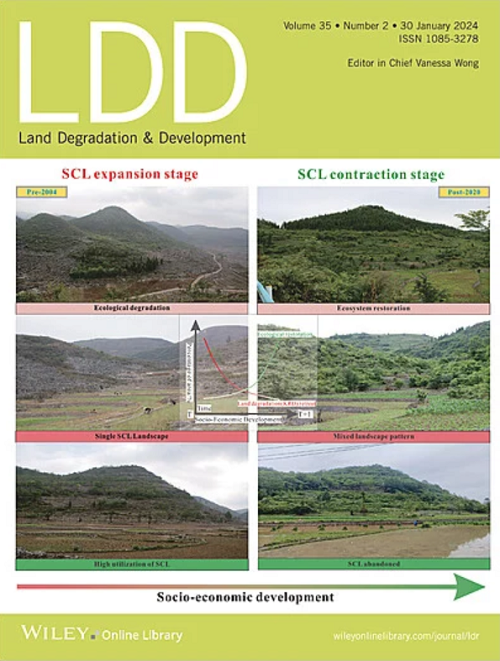Removal Mechanism of Carbendazim in Water by Ozone and Remediation of Carbendazim Pollution in Soil
IF 3.6
2区 农林科学
Q2 ENVIRONMENTAL SCIENCES
引用次数: 0
Abstract
Carbendazim, a commonly used fungicide, was identified as a contributor to soil degradation. Despite the extensive use of carbendazim, the degradation mechanisms and the removal process of carbendazim in the soil environment were not yet fully understood. A deeper understanding of the degradation pathways of carbendazim was considered essential for developing effective strategies to mitigate long-term environmental impacts. The degradation of carbendazim using ozone in water and soil environments was investigated with the simulation experiments of ozone exposure in water and soil, and the degradation pathways and removal efficiency of carbendazim in water were also explored under different conditions in the study. The results showed that ozone-induced degradation proceeded in three stages: rapid removal, slow removal, and equilibrium. In water, ozone directly reacted with carbendazim, generating hydroxyl radicals (˙OH), which oxidized carbendazim into intermediates, including 2-aminobenzimidazole, 2-hydroxybenzimidazole, 2-benzimidazolone, and o-phenylenediamine. The intermediates eventually degraded into nontoxic byproducts such as carbon dioxide and water. In soil, ozone treatment enhanced the removal of carbendazim by catalyzing the production of active substances, including hydroxyl radicals (˙OH) and hydrogen peroxide (H2O2). Increasing the aeration frequency to four times daily significantly improved the efficiency of carbendazim removal, reaching the peak removal rate of 70.4% after 21 days of ozone exposure in the soil. The findings of this study clarified the theoretical mechanisms of ozone treatment for carbendazim remediation, highlighted the critical role of hydroxyl radicals (˙OH) in the degradation process, and established a scientific foundation for developing remediation strategies targeting carbendazim-induced soil contamination.臭氧对水中多菌灵的去除机理及土壤多菌灵污染的修复
多菌灵是一种常用的杀真菌剂,被认为是造成土壤退化的一个因素。尽管多菌灵被广泛使用,但人们对多菌灵在土壤环境中的降解机制和清除过程尚未完全了解。深入了解多菌灵的降解途径被认为是制定有效战略以减轻长期环境影响的关键。本研究利用臭氧在水和土壤环境中的暴露模拟实验,研究了多菌灵在水和土壤环境中的降解情况,并探讨了不同条件下多菌灵在水中的降解途径和去除效率。结果表明,臭氧诱导的降解过程分为三个阶段:快速去除、缓慢去除和平衡。在水中,臭氧直接与多菌灵发生反应,产生羟自由基(˙OH),将多菌灵氧化成中间产物,包括 2-氨基苯并咪唑、2-羟基苯并咪唑、2-苯并咪唑酮和邻苯二胺。这些中间产物最终会降解为二氧化碳和水等无毒副产品。在土壤中,臭氧处理通过催化羟基自由基(˙OH)和过氧化氢(H2O2)等活性物质的产生,提高了多菌灵的去除率。将曝气次数增加到每天四次可显著提高多菌灵的去除效率,在土壤中曝露臭氧 21 天后,多菌灵的去除率达到峰值 70.4%。该研究结果阐明了臭氧处理多菌灵修复的理论机制,强调了羟基自由基(˙OH)在降解过程中的关键作用,为制定针对多菌灵引起的土壤污染的修复策略奠定了科学基础。
本文章由计算机程序翻译,如有差异,请以英文原文为准。
求助全文
约1分钟内获得全文
求助全文
来源期刊

Land Degradation & Development
农林科学-环境科学
CiteScore
7.70
自引率
8.50%
发文量
379
审稿时长
5.5 months
期刊介绍:
Land Degradation & Development is an international journal which seeks to promote rational study of the recognition, monitoring, control and rehabilitation of degradation in terrestrial environments. The journal focuses on:
- what land degradation is;
- what causes land degradation;
- the impacts of land degradation
- the scale of land degradation;
- the history, current status or future trends of land degradation;
- avoidance, mitigation and control of land degradation;
- remedial actions to rehabilitate or restore degraded land;
- sustainable land management.
 求助内容:
求助内容: 应助结果提醒方式:
应助结果提醒方式:


